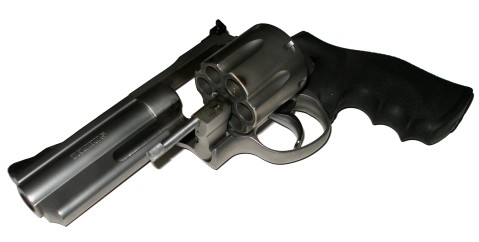
Sometimes it is tough for me to write a piece that doesn’t put me to sleep mid sentence. So when you doze while reading some of my stuff, I can empathize, I’ve been there myself. So take a short nap beforehand, and try to get through what follows, because the Taurus Model 44 double action revolver and the 44 Remington Magnum cartridge are far better than this representation, a combination with a tremendous amount of personality as well as utility. This is one of the few times in recent months that I have not rushed to clean up a firearm after a range session because I knew it would not be idle for long. I have included some non cylinder bursting handloads that were developed during this project.
The double action re-vol-ver… really?
A great firearm is one that can be shot with relaxed confidence, serves its intended purpose and leaves the shooter with a smile on his face. That’s exactly how I would describe my handloading and shooting experience with the Taurus Model 44 and the 44 Remington Magnum combination. After a few hundred rounds, I have developed several well founded theories, more specifically…
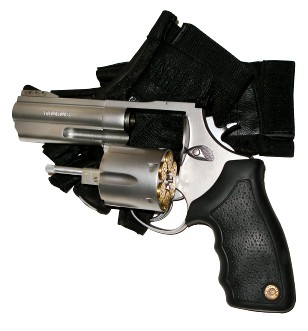 I believe the single most important reason to select a double action revolver over a single action revolver is that a single action revolver always seems like it’s broken. Why would anyone want to pull back a hammer and pull a trigger to discharge a round? With a double action revolver, you just pull the trigger, squeeze the trigger for the sake of literary preciseness, and you’re good to go. This is of particular importance to those of us who suffer from Abbreviated and/or Vestigial Pollex Syndrome. The Taurus Model 44 trigger pull, after many frame and cylinder pounding rounds, settled in at a 9 lb double action. For the persistent two steppers among us, single action pull remained at 4 lbs. No matter how many times I attempted to trick the Taurus, with multiple pulls at the digital scale, the readings were consistently the same.
I believe the single most important reason to select a double action revolver over a single action revolver is that a single action revolver always seems like it’s broken. Why would anyone want to pull back a hammer and pull a trigger to discharge a round? With a double action revolver, you just pull the trigger, squeeze the trigger for the sake of literary preciseness, and you’re good to go. This is of particular importance to those of us who suffer from Abbreviated and/or Vestigial Pollex Syndrome. The Taurus Model 44 trigger pull, after many frame and cylinder pounding rounds, settled in at a 9 lb double action. For the persistent two steppers among us, single action pull remained at 4 lbs. No matter how many times I attempted to trick the Taurus, with multiple pulls at the digital scale, the readings were consistently the same.
The second most important reason to select a double action revolver is that the cylinder swings out to be refilled, willingly. A double action revolver has no little secret compartment to flip open to uncover singularly exposed chambers, and the cylinder doesn’t go “click, click, click” while you rotate the cylinder to load each round. With a double action revolver, when that big bear you already shot six times in defense of your new fly rod is at 20 feet and closing, you can at least reload quickly and keep shooting as though it would matter. During heavy non-bear related shooting, the Taurus cylinder never unlocked or popped open under recoil, nor did it bind from a carbon filled cylinder gap. At the end of the day, clean cylinder gap remained at 0.004″ and holding back the hammer with a depressed trigger resulted in near zero cylinder rock.
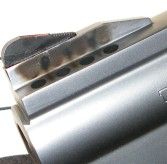 Unlike the crescent front sights found on some fancy lad CAS guns and autoloaders, the Taurus large front ramp and bright International orange blade are clearly visible. The Taurus pumps a lot of powder and bullet residue through the barrel’s expansion chamber and vertically arranged ports. The spray on the front sight ramp does not discolor the bright orange insert, but does suggest it is a firearm heavily at work. The front
Unlike the crescent front sights found on some fancy lad CAS guns and autoloaders, the Taurus large front ramp and bright International orange blade are clearly visible. The Taurus pumps a lot of powder and bullet residue through the barrel’s expansion chamber and vertically arranged ports. The spray on the front sight ramp does not discolor the bright orange insert, but does suggest it is a firearm heavily at work. The front 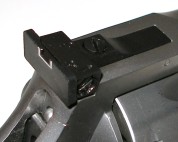 sight is pinned to facilitate service, do not know if accessory blades are available for sight tuning.
sight is pinned to facilitate service, do not know if accessory blades are available for sight tuning.
As an additional bonus the rear sight moves up and down as well as side to side with a good deal of conviction; fully adjustable for windage and elevation. The adjustments are precise and tactile and they stay put no matter how much they get bounced around. With my eyesight I have to shoot by Braille, but this set up worked very well for me. The 4″ barrel, while short, still provides a 6″ sight radius which is actually pretty comfortable.
In terms of range sessions where hundreds of rounds of ammo are fired from the gun in factory form, its sort of like drinking Tequila shooters in a SoCal biker bar; good in concept, fun for a while, but not so great when you wake up in the morning with a hang over and in a body cast. 180 grain handloads zipping along at 1600 fps are easy to shoot and offer more power than pumped up 45 ACP +P loads. The revolver’s 46 ounces of stainless steel can dampen a lot of recoil. On the other hand, heavy 300 grain handloads, fired in substantial quantity, can jar your fillings loose and send you looking for a good pair of shooting gloves and better than factory supplied shock absorbing grips.
Since you brought it up…
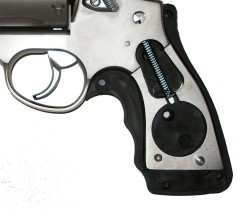
The stock Model 44 grips are not all that bad. They are relatively comfortable while shooting heavy loads in reasonable quantities and they offer an OK grip. However, they are narrow and a bit slab sided and tend to dig into the shooter’s palm after a sustained shooting session. Just like the recoil pad on a magnum rifle, wider grips spread recoil over a larger surface can make a big difference in shooting comfort, but finding them for this model Taurus is not an easy task. Hogue catalogues several versions of very nice exotic wood grips that seem about right, but each attempt at giving Hogue $70 was met with a 90 day backorder advisory. Eventually, I settled for a Hogue rubber Monogrip. The stock grip, pictured left, covers the backstrap completely, the $20 Monogrip does not.
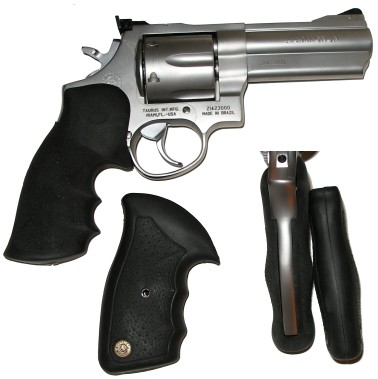
The picture inset to the right, yes your right, is a pretty good illustration of the additional width of the installed Hogue Monogrip and how noticeably smaller it is, front to back, at the first finger groove. While longer at the heel the finger grip area is actually the same as the factory unit. The deeper grooves make for a much better hold and positive finger placement which, of course, make for a significantly more control when shooting. In comparing the first range session with the Taurus to this extended shooting session with much heavier loads, the Hogue grips are significantly better in dampening recoil, even with the exposed backstrap, and the improved hold directly improved shooting accuracy.
It would be nice if manufacturers dropped the traditional revolver grip frame altogether and changed to a smaller rectangular or cylindrical shank designed to retain springs and provide only a mounting surface for a more free formed grip. This type of grip would provide better protection from recoil and allow a much more ergonomic grip design. Sort of like a rifle stock, only much, much. much smaller and without a cheek piece. In fact, T/C Contender grips are mounted this way, lever action rifles…
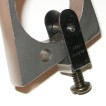 Monogrips are easy to install and, unlike mono-brows, are an aesthetic enhancement . The original grip locator pin is removed, the Hogue bracket is secured to the frame, the new grip is slipped on while the bracket is fished around for alignment and secured with a single screw at the bottom. The front of the gun’s frame can be paper or plastic strip shimmed to optimize fit at the backstrap. Is a replacement grip absolutely essential ? No, but this inexpensive accessory significantly enhanced the gun’s handling and shooting comfort.
Monogrips are easy to install and, unlike mono-brows, are an aesthetic enhancement . The original grip locator pin is removed, the Hogue bracket is secured to the frame, the new grip is slipped on while the bracket is fished around for alignment and secured with a single screw at the bottom. The front of the gun’s frame can be paper or plastic strip shimmed to optimize fit at the backstrap. Is a replacement grip absolutely essential ? No, but this inexpensive accessory significantly enhanced the gun’s handling and shooting comfort.
The Taurus works even better with ammo…
Maybe it’s because I handload oddball rounds like the 17-357 RG and 7.62x38R Nagant revolver, but I’ll go out on a limb here and say the 44 Remington Magnum is an easy cartridge to handload. The large bullet diameter and comparatively short case make it easy to peek in and check for a missed charge and slow powder handloads are near case full making double charging a challenging task. Cannelured bullets take the guess work out of establishing COL and brass life is excellent. Other than cleaning, sizing, and case mouth expanding, there isn’t a whole lot to case prep.
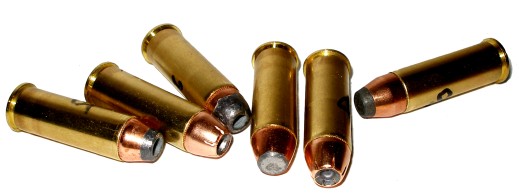
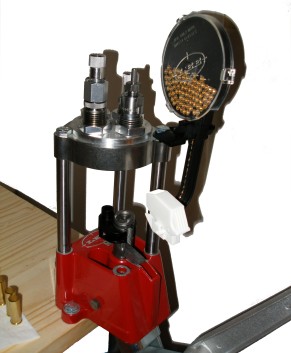 A Lee Precision 4 Hole Turret Press and Deluxe Pistol Die set; sizer, expander, seater and factory crimp were used for development and production loading. The dies set is for either 44 Special or 44 Magnum rounds. I removed the press’ auto indexing rod for the short quantity loads, manually indexing the turret head to the required station, then reinstalled the auto index rod for production. The Lee Safety Prime system and Pro Auto Disk expander die mounted measure were used to prime and charge respectively. Nice set up and intelligently engineered equipment; one of the truly great values in handloading equipment.
A Lee Precision 4 Hole Turret Press and Deluxe Pistol Die set; sizer, expander, seater and factory crimp were used for development and production loading. The dies set is for either 44 Special or 44 Magnum rounds. I removed the press’ auto indexing rod for the short quantity loads, manually indexing the turret head to the required station, then reinstalled the auto index rod for production. The Lee Safety Prime system and Pro Auto Disk expander die mounted measure were used to prime and charge respectively. Nice set up and intelligently engineered equipment; one of the truly great values in handloading equipment.
I did not cover light loads in detail within the data appearing in the table below, because they are outside of the scope of this project. However, I did want to offer a perspective. I do not shoot 44 Special or 44 Russian ammo in 44 Remington Magnum firearms. The 44 mag case length is 1.285″, the 44 Special 1.160″ and the Russian 0.970″. Respective capacities are: 37.6 grains, 33.4 grains and 27.4 grains of water. I believe, after a time, exposed chamber surfaces and throats would become scored by hot gases and powder until this would eventually impede chambering and extraction of full length rounds and possibly the gun’s accuracy. I also see no benefit as there is no great cost benefit, if any, and 44 Remington Magnum brass can easily be loaded lighter. A 200 grain cast Oregon Trail bullet with a 1.560″ COL and 4.5 grains of Bullseye would result in a 700 fps round. 6.0 grains of HP38 would make sure a good 800 fps load. Both use a standard large pistol primer.
I’ve heard the 44 Magnum is a dangerous cartridge to light load for practice rounds with cast bullets, but I absolutely don’t subscribe to related tales of run away pressures when loading trickle size charges of fast powder. I do subscribe to the notion that people tend to make careless mistakes and double charge or worse with very fast powders, then look for a way out of the embarrassment which usually includes: blaming the handload data, blaming the powder producer and/or blaming the firearm manufacturer. Anyone who has routinely shot salt shaker sounding standard 45 Colt factory loads, or light handloads the 45 Colt with its 42 – 43 grains of capacity knows that less than case full loads do not make for runaway pressures.
I am not suggesting powders being used in environments not intended by their producers won’t develop strange pressure curves. As an example, H110 is typically used for dense loads and relatively high pressures. It’s burn characteristics vary when this powder is loaded in small charges in an attempt to produce low velocity loads, so don’t cut H110 loads to make low velocity 44 Magnum ammo. Some powders used routinely in magnum handloads were originally intended for low pressure scatter gun applications. Some of these do strange things when loaded up heavily and at twice the intended operating pressures. However, nothing in this last paragraph has anything to do with loading 4.5 grains of Bullseye, a powder intended for modest pressures and small charges, in low velocity loads for the 44 Magnum, despite the cartridge’s much larger capacity.
The bullets selected are typical of what is available and how bullets fly from this 4″ barrel revolver. Even the Sierra heavyweight 300 grain at approximately 0.100″ over max spec COL for the 44 Magnum worked with no problem at all.
|
Handload Results |
|||||||||
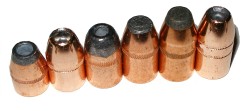 |
|||||||||
| Bullet Type | Bullet Weight |
Bullet Diameter |
C.O.L. | Net Water Capacity |
Powder Type |
Charge | Primer Type |
Muzzle Velocity |
Muzzle Energy |
| Remington SJHP | 180 | 0.430 | 1.600 | 30.2 | H110 | 29.0 | CCI 350 | 1460 | 852 |
| Remington SJHP | 180 | 0.430 | 1.600 | 30.2 | H110 | 31.5 | CCI 350 | 1598 | 1021 |
| Remington SJHP | 180 | 0.430 | 1.600 | 30.2 | Li’l Gun | 29.0 | CCI 350 | 1478 | 873 |
| Remington SJHP | 180 | 0.430 | 1.600 | 30.2 | Li’l Gun | 31.5 | CCI 350 | 1638 | 1073 |
| Remington SJHP | 180 | 0.430 | 1.600 | 30.2 | AA 9 | 24.0 | CCI 350 | 1550 | 960 |
| Remington SJHP | 180 | 0.430 | 1.600 | 30.2 | AA 9 | 25.0 | CCI 350 | 1599 | 1022 |
| Remington SJHP | 180 | 0.430 | 1.600 | 30.2 | 2400 | 24.0 | CCI 350 | 1414 | 799 |
| Remington SJHP | 180 | 0.430 | 1.600 | 30.2 | 2400 | 25.0 | CCI 350 | 1498 | 897 |
| Hornady XTP/HP | 240 | 0.430 | 1.600 | 26.6 | H110 | 24.5 | CCI 350 | 1303 | 905 |
| Hornady XTP/HP | 240 | 0.430 | 1.600 | 26.6 | H110 | 25.0 | CCI 350 | 1330 | 943 |
| Hornady XTP/HP | 240 | 0.430 | 1.600 | 26.6 | Li’l Gun | 22.0 | CCI 350 | 1258 | 844 |
| Hornady XTP/HP | 240 | 0.430 | 1.600 | 26.6 | Li’l Gun | 23.0 | CCI 350 | 1280 | 873 |
| Hornady XTP/HP | 240 | 0.430 | 1.600 | 26.6 | AA 9 | 20.5 | CCI 350 | 1324 | 934 |
| Hornady XTP/HP | 240 | 0.430 | 1.600 | 26.6 | AA 9 | 21.6 | CCI 350 | 1366 | 995 |
| Hornady XTP/HP | 240 | 0.430 | 1.600 | 26.6 | Enforcer | 21.0 | CCI 350 | 1172 | 732 |
| Hornady XTP/HP | 240 | 0.430 | 1.600 | 26.6 | Enforcer | 22.0 | CCI 350 | 1280 | 873 |
| Remington SJHP | 240 | 0.430 | 1.600 | 24.8 | H110 | 25.0 | CCI 350 | 1323 | 933 |
| Remington SJHP | 240 | 0.430 | 1.600 | 24.8 | H110 | 25.5 | CCI 350 | 1366 | 995 |
| Remington SJHP | 240 | 0.430 | 1.600 | 24.8 | Li’l Gun | 21.5 | CCI 350 | 1251 | 834 |
| Remington SJHP | 240 | 0.430 | 1.600 | 24.8 | Li’l Gun | 22.5 | CCI 350 | 1261 | 848 |
| Remington SJHP | 240 | 0.430 | 1.600 | 24.8 | 2400 | 20.0 | CCI 350 | 1242 | 822 |
| Remington SJHP | 240 | 0.430 | 1.600 | 24.8 | 2400 | 20.5 | CCI 350 | 1306 | 909 |
| Remington SJHP | 240 | 0.430 | 1.600 | 24.8 | AA 9 | 20.0 | CCI 350 | 1325 | 936 |
| Remington SJHP | 240 | 0.430 | 1.600 | 24.8 | AA 9 | 20.2 | CCI 350 | 1325 | 936 |
| Remington SJHP | 240 | 0.430 | 1.600 | 24.8 | Enforcer | 21.0 | CCI 350 | 1228 | 804 |
| Remington SJHP | 240 | 0.430 | 1.600 | 24.8 | Enforcer | 22.0 | CCI 350 | 1296 | 895 |
| Speer Gold Dot HP | 270 | 0.429 | 1.585 | 23.3 | H110 | 23.0 | CCI 350 | 1254 | 943 |
| Speer Gold Dot HP | 270 | 0.429 | 1.585 | 23.3 | H110 | 23.8 | CCI 350 | 1280 | 983 |
| Speer Gold Dot HP | 270 | 0.429 | 1.585 | 23.3 | Li’l Gun | 19.5 | CCI 350 | 1142 | 782 |
| Speer Gold Dot HP | 270 | 0.429 | 1.585 | 23.3 | Li’l Gun | 22.0 | CCI 350 | 1292 | 1001 |
| Speer Gold Dot HP | 270 | 0.429 | 1.585 | 23.3 | 2400 | 18.5 | CCI 350 | 1190 | 849 |
| Speer Gold Dot HP | 270 | 0.429 | 1.585 | 23.3 | 2400 | 19.0 | CCI 350 | 1209 | 877 |
| Speer Gold Dot HP | 270 | 0.429 | 1.585 | 23.3 | AA 9 | 18.0 | CCI 350 | 1158 | 804 |
| Speer Gold Dot HP | 270 | 0.429 | 1.585 | 23.3 | AA 9 | 18.8 | CCI 350 | 1195 | 856 |
| Speer Gold Dot HP | 270 | 0.429 | 1.585 | 23.3 | Enforcer | 20.0 | CCI 350 | 1175 | 828 |
| Speer Gold Dot HP | 270 | 0.429 | 1.585 | 23.3 | Enforcer | 20.5 | CCI 350 | 1180 | 835 |
| Sierra JSP | 300 | 0.429 | 1.725 | 23.4 | H110 | 20.0 | CCI 350 | 1148 | 878 |
| Sierra JSP | 300 | 0.429 | 1.725 | 23.4 | H110 | 20.8 | CCI 350 | 1209 | 974 |
| Sierra JSP | 300 | 0.429 | 1.725 | 23.4 | Li’l Gun | 16.5 | CCI 350 | 1072 | 766 |
| Sierra JSP | 300 | 0.429 | 1.725 | 23.4 | Li’l Gun | 17.7 | CCI 350 | 1101 | 808 |
| Sierra JSP | 300 | 0.429 | 1.725 | 23.4 | 2400 | 16.5 | CCI 350 | 1082 | 780 |
| Sierra JSP | 300 | 0.429 | 1.725 | 23.4 | 2400 | 17.2 | CCI 350 | 1067 | 759 |
| Sierra JSP | 300 | 0.429 | 1.725 | 23.4 | AA 9 | 16.2 | CCI 350 | 1066 | 757 |
| Sierra JSP | 300 | 0.429 | 1.725 | 23.4 | AA 9 | 16.8 | CCI 350 | 1085 | 784 |
| Sierra JSP | 300 | 0.429 | 1.725 | 23.4 | Enforcer | 17.5 | CCI 350 | 1067 | 759 |
| Sierra JSP | 300 | 0.429 | 1.725 | 23.4 | Enforcer | 18.5 | CCI 350 | 1105 | 814 |
| Hornady XTP/HP | 300 | 0.430 | 1.600 | 18.3 | H110 | 21.5 | CCI 350 | 1136 | 860 |
| Hornady XTP/HP | 300 | 0.430 | 1.600 | 18.3 | H110 | 22.5 | CCI 350 | 1154 | 887 |
| Hornady XTP/HP | 300 | 0.430 | 1.600 | 18.3 | Li’l Gun | 17.6 | CCI 350 | 1040 | 721 |
| Hornady XTP/HP | 300 | 0.430 | 1.600 | 18.3 | Li’l Gun | 18.5 | CCI 350 | 1123 | 840 |
| Hornady XTP/HP | 300 | 0.430 | 1.600 | 18.3 | 2400 | 17.5 | CCI 350 | 1125 | 843 |
| Hornady XTP/HP | 300 | 0.430 | 1.600 | 18.3 | 2400 | 18.0 | CCI 350 | 1143 | 871 |
| Hornady XTP/HP | 300 | 0.430 | 1.600 | 18.3 | AA 9 | 17.0 | CCI 350 | 1046 | 729 |
| Hornady XTP/HP | 300 | 0.430 | 1.600 | 18.3 | AA 9 | 17.6 | CCI 350 | 1130 | 851 |
| Hornady XTP/HP | 300 | 0.430 | 1.600 | 18.3 | Enforcer | 19.0 | CCI 350 | 1082 | 780 |
| Hornady XTP/HP | 300 | 0.430 | 1.600 | 18.3 | Enforcer | 19.6 | CCI 350 | 1159 | 895 |
The good news is the Taurus and 44 Remington Magnum gave me what I was looking for at both ends of the weight spectrum. The gun put out over 50% more velocity than 45 ACP 185 grain +P loads and twice the muzzle energy. I was also more than pleased with bumping 1,200 fps with 300 grain slugs, particularly since that round proved so manageable. In fact, the 44 Magnum performance in the compact revolver came very close to the heaviest 45 Colt jacketed bullet loads I push through my 7 1/2″ barrel Ruger Bisley. Yes, I was very please with the results.
Accuracy and shooting impressions…
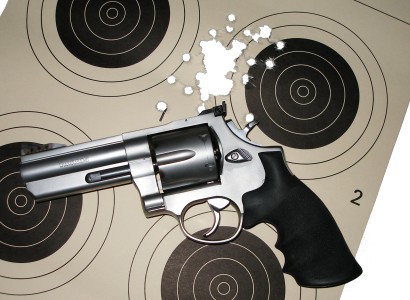
My 100 shot, through the chronograph, 25 yard group measured about 4 1/2″, comprised of samples from the loads noted on the table. Not bad for sandbag steadied shooting with such a wide weight and charge spread. Recoil and muzzle jump weren’t bad at all and hundreds of rounds did not require ambulance pickup. The gun was covered with soot at the end of the day, lube managed to get pressured out of every seam and joint of the gun, but it was as tight as the start of the session.
What is the potential accuracy of the combination from a Ransom Rest? I don’t know, I never shoot at anything with a gun bolted into a fixture. I know at it’s best the combination can shoot under 2″ at 25 yards with casual sandbag support and at it’s worse under 3 1/2″ at the same distance. Yes, a fixture that takes a shooter out of the process can pretty effectively measure mechanical accuracy, but not real world potential, as it can’t measure how controllable a given firearm is with a particular load. I think there is a slight of hand routine going on in a lot of recent articles about the really big handguns. Someone will review a 2 1/2″ barrel X Frame 500 S&W, shoot it from a Ransom Rest and report 2″ group accuracy at 50 yards. The comment is pointless as, for almost everyone, this is a highly uncontrollable combination. The misleading review causes people to go out an buy the gun with the reported test accuracy expectation. When shooters have to measure three shot groups in yards, rather than a handful of inches, they blame themselves rather than the pin head marketing that produced such a ridiculous firearm. If I can hit 3 1/2″ group at 25 yards with this gun, it is a fair bet most anyone else could also, even if perhaps with a little routine practice.
The bad news, the Taurus is not good for skeet…
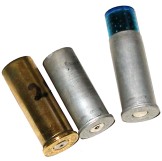
I couldn’t help myself, I had to try CCI 44 Special/Magnum shot loads in the short barrel Taurus, something I believe I am not suppose to do because of the gun’s porting. If it is a snake load application, this might work as a good third of the loads 170 pellets hit within a square foot at 7 yards. Beyond that range, the snake would have to be relatively thick to take a hit or death would have to come from throwing the $10 box of 10 rounds, or perhaps the ever popular, pre 1945 western, last resort empty gun toss. The CCI brand shot shells are 44 Special in length and made of aluminum like Blazer ammo that can’t be reloaded. Standalone shot capsules are of course available for 44 mag handloaders.
And back to where we came in…
I don’t like to tell her, because she gets really mad, but my wife is kind of a shrimp. She insists she use to be 5′ 6″ as a teen, but has since shrunken to 5′ even. I’ve known her since before she was a teen, I’m kind of a shrimp 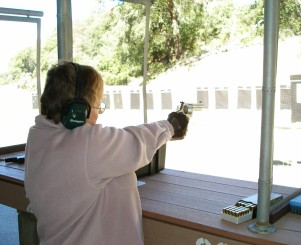 also, but I can’t recall her ever obstructed my view while standing in front of me. At the end of the data collection session, she took the Taurus, and a variety of loads, and spent a good half hour shooting at 25 yard targets. Unfortunately, once she started shooting I had to sit on the bench and watch until she ran out of ammo. Diane’s groups, shot two hand as pictured, were 1 3/4″ to 3 1/2″. She wore a shooting glove, but felt the recoil was less than heavy 45 Colt loads shot from a single action Ruger. We both agree the gun is compact, balanced and an excellent shooter. Now, if I can get it back from her, it will replace my P229 357 SIG when working out away from the house in Maine. Maybe it will get me a deer or black bear in the fall. I’m glad I had a chance to slow down, get off of the trend of the week firearms and work with something that is fun.
also, but I can’t recall her ever obstructed my view while standing in front of me. At the end of the data collection session, she took the Taurus, and a variety of loads, and spent a good half hour shooting at 25 yard targets. Unfortunately, once she started shooting I had to sit on the bench and watch until she ran out of ammo. Diane’s groups, shot two hand as pictured, were 1 3/4″ to 3 1/2″. She wore a shooting glove, but felt the recoil was less than heavy 45 Colt loads shot from a single action Ruger. We both agree the gun is compact, balanced and an excellent shooter. Now, if I can get it back from her, it will replace my P229 357 SIG when working out away from the house in Maine. Maybe it will get me a deer or black bear in the fall. I’m glad I had a chance to slow down, get off of the trend of the week firearms and work with something that is fun.
For more on the Taurus and 44 Magnum revolver handloads –
When Longevity Trumps New…gevity Part I
When Longevity Trumps New…gevity Part II
When Longevity Trumps New…gevity Part III
44 Remington Magnum Handload Data
If you’re looking for a handgun, rifle or shotgun, check availability at RGI – Maine Guns, we ship to all 50 states and offer competitive prices, new guns and full factory warranties.
Thanks,
Joe

Email Notification